Citroen GRAND C4 PICASSO RHD 2016 2.G Owner's Manual
Manufacturer: CITROEN, Model Year: 2016, Model line: GRAND C4 PICASSO RHD, Model: Citroen GRAND C4 PICASSO RHD 2016 2.GPages: 523, PDF Size: 13.63 MB
Page 131 of 523
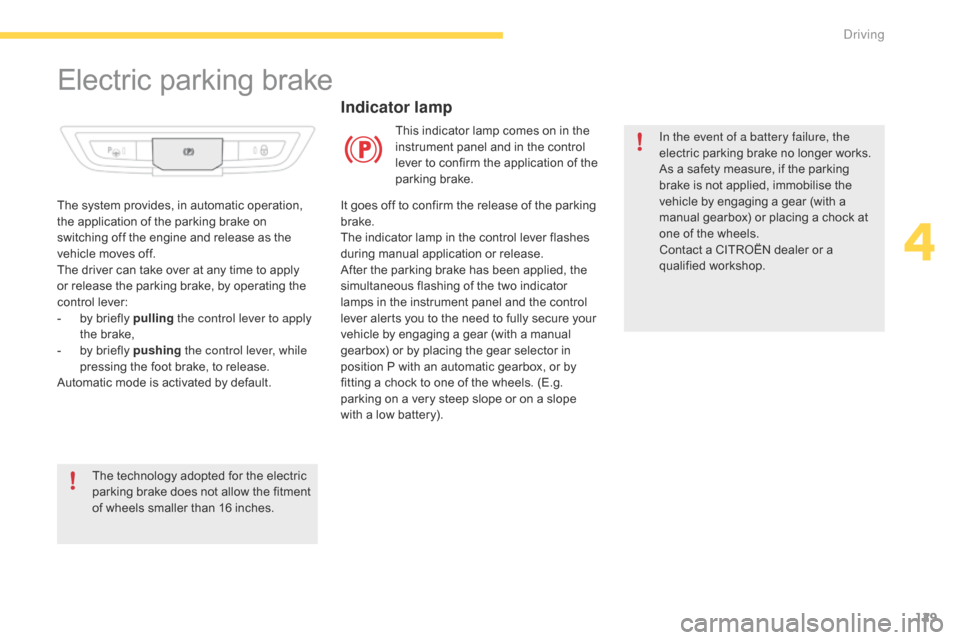
129
Electricô parkingô brake
In the event of a battery failure, the
electricô parking ô brake ô no ô longer ô works.
As
ô a ô safety ô measure, ô if ô the ô parking ô
b
rake ô is ô not ô applied, ô immobilise ô the ô
v
ehicle ô by ô engaging ô a ô gear ô (with ô a ô
m
anual ô gearbox) ô or ô placing ô a ô chock ô at ô
o
ne ô of ô the ô wheels.
Contact
ô a ô CITROûN ô dealer ô or ô a ô
q
ualified
ô w
orkshop.
Indicator lamp
Thisô indicatorô lampô comesô onô inô theô instrument ô panel ô and ô in ô the ô control ô
l
ever ô to ô confirm ô the ô application ô of ô the ô
par
king
ô b
rake.
The
ô
system
ô
provides,
ô
in
ô
automatic
ô
operation,
ô
t
he
ô
application
ô
of
ô
the
ô
parking
ô
brake
ô
on
ô
s
witching
ô
off
ô
the
ô
engine
ô
and
ô
release
ô
as
ô
the
ô
v
ehicle
ô
moves
ô
off.
The
ô
driver
ô
can
ô
take
ô
over
ô
at
ô
any
ô
time
ô
to
ô
apply
ô
o
r
ô
release
ô
the
ô
parking
ô
brake,
ô
by
ô
operating
ô
the
ô
c
ontrol
ô
lever:
-
ô
b
y
ô
briefly
ô
pulling the control lever to apply
the
ô
brake,
-
ô
b
y
ô
briefly
ô
pushing the control lever, while
pressing
ô
the
ô
foot
ô
brake,
ô
to
ô
release.
Automatic
ô
mode
ô
is
ô
activated
ô
by
ô
default.
The
ô
technology
ô
adopted
ô
for
ô
the
ô
electric
ô
p
arking
ô
brake
ô
does
ô
not
ô
allow
ô
the
ô
fitment
ô
o
f
ô
wheels
ô
smaller
ô
than
ô
16
ô
inches. It
ô
goes
ô
off
ô to ô confirm ô the ô release ô of ô the ô parking ô
b
rake.
The
ô
indicator ô lamp ô in ô the ô control ô lever ô flashes ô
d
uring
ô
manual ô application ô or ô release.
After
ô
the
ô
parking ô brake ô has ô been ô applied, ô the ô
s
imultaneous ô flashing ô of ô the ô two ô indicator ô
l
amps
ô
in
ô
the ô instrument ô panel ô and ô the ô control ô
l
ever
ô
alerts ô you ô to ô the ô need ô to ô fully ô secure ô your ô
v
ehicle
ô
by
ô engaging ô a ô gear ô (with ô a ô manual ô
g
earbox)
ô
or ô by ô placing ô the ô gear ô selector ô in ô
p
osition
ô
P
ô with ô an ô automatic ô gearbox, ô or ô by ô
f
itting
ô
a
ô
chock ô to ô one ô of ô the ô wheels. ô (E.g. ô
p
arking
ô
on ô a ô very ô steep ô slope ô or ô on ô a ô slope ô
w
ith
ô
a
ô
low
ô battery).
4
Driving
Page 132 of 523
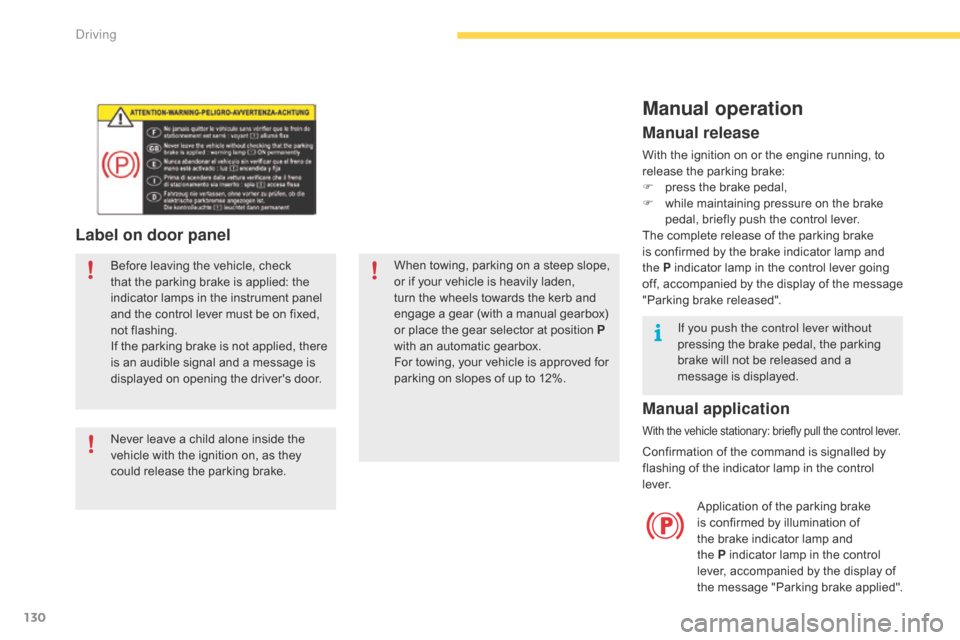
130
Label on door panel
Beforeô leavingô theô vehicle,ô checkô that ô the ô parking ô brake ô is ô applied: ô the ô
i
ndicator ô lamps ô in ô the ô instrument ô panel ô
a
nd ô the ô control ô lever ô must ô be ô on ô fixed, ô
n
ot
ô f
lashing.
If
ô the ô parking ô brake ô is ô not ô applied, ô there ô
i
s ô an ô audible ô signal ô and ô a ô message ô is ô
d
isplayed ô on ô opening ô the ô driver's ô door.
Never
ô leave ô a ô child ô alone ô inside ô the ô
v
ehicle ô with ô the ô ignition ô on, ô as ô they ô
c
ould ô release ô the ô parking ô brake.When
ô towing, ô parking ô on ô a ô steep ô slope, ô o
r ô if ô your ô vehicle ô is ô heavily ô laden, ô
t
urn ô the ô wheels ô towards ô the ô kerb ô and ô
e
ngage ô a ô gear ô (with ô a ô manual ô gearbox) ô
o
r ô place ô the ô gear ô selector ô at ô position ô P
with
ô an ô automatic ô gearbox.
For
ô towing, ô your ô vehicle ô is ô approved ô for ô
p
arking ô on ô slopes ô of ô up ô to ô 12%.
Manual operation
Applicationô ofô theô parkingô brakeô is ô confirmed ô by ô illumination ô of ô
t
he ô brake ô indicator ô lamp ô and ô
t
he Pô indicator ô lamp ô in ô the ô control ô
l
ever, ô accompanied ô by ô the ô display ô of ô
t
he
ô m
essage
ô "
Parking
ô b
rake
ô a
pplied".
Manual release
Withô theô ignitionô onô orô theô engineô running,ô toô release ô the ô parking ô brake:
F
ô
p
ress ô the ô brake ô pedal,
F
ô
w
hile ô maintaining ô pressure ô on ô the ô brake ô
p
edal, ô briefly ô push ô the ô control ô lever.
The
ô complete ô release ô of ô the ô parking ô brake ô
i
s ô confirmed ô by ô the ô brake ô indicator ô lamp ô and ô
t
he Pô indicator ô lamp ô in ô the ô control ô lever ô going ô
o
ff, ô
a
ccompanied ô
b
y ô
t
he ô
d
isplay ô
o
f ô
t
he ô
m
essage ô
"
Parking ô brake ô released".
If you push the control lever without
pressing
ô the ô brake ô pedal, ô the ô parking ô
b
rake ô will ô not ô be ô released ô and ô a ô
m
essage ô is ô displayed.
Manual application
Withô theô vehicleô stationary:ô brieflyô pullô theô controlô lever.
Confirmationô ofô theô commandô isô signalledô byô flashing ô of ô the ô indicator ô lamp ô in ô the ô control ô
l
eve r.
Driving
Page 133 of 523

131
Withô theô vehicleô stationary,ô theô parkingô brakeô is automatically applied when the engine
is switched off
ô by ô pressing ô the ô START/STOP ô
b
utton. Application
ô of ô the ô parking ô brake ô
i
s ô confirmed ô by ô illumination ô of ô
t
he ô brake ô indicator ô lamp ô and ô
t
he Pô indicator ô lamp ô in ô the ô control ô
l
ever, ô accompanied ô by ô the ô display ô of ô
t
he
ô m
essage
ô "
Parking
ô b
rake
ô a
pplied".
With
ô the ô engine ô stalled ô or ô in ô STOP ô
m
ode ô of ô Stop ô & ô Start, ô automatic ô
a
pplication ô does ô not ô take ô place.
In
ô automatic ô mode, ô you ô can ô manually ô
a
pply ô
o
r ô
r
elease ô
t
he ô
p
arking ô
b
rake ô
u
sing ô
t
he ô control ô lever.
Automatic operation
Automatic release
Theô completeô releaseô ofô theô parkingô brake ô is ô confirmed ô by ô the ô brake ô
i
ndicator ô lamp ô and ô the ô P ô indicator ô
l
amp ô in ô the ô control ô lever ô going ô off, ô
a
ccompanied ô by ô the ô display ô of ô the ô
m
essage ô "Parking ô brake ô released".
Whenô stationaryô withô theô engineô running,ô doô notô depress ô the ô accelerator ô pedal ô unnecessarily,ô y
ou ô risk ô releasing ô the ô parking ô brake.
Ensureô firstô thatô theô engineô isô runningô andô theô driver's ô door ô is ô properly ô closed.
The
ô electric ô parking ô brake ô releases
automatically and progressively when you
press
ô the ô accelerator:
F
ô
M
anual ô gearbox: ô fully ô depress ô the ô clutch ô
p
edal, ô engage ô 1
stô orô reverseô gear;ô pressô t
he
ô
accelerator
ô
pedal ô and ô let ô up ô the ô clutch ô
ped
al.
F
ô
A
utomatic
ô
gearbox: ô select ô position ô D, M or
R
ô
then
ô
press
ô
the
ô accelerator.
Automatic application
Withô anô automaticô gearbox,ô ifô theô brakeô d oes ô not ô release ô automatically, ô check ô
t
hat ô the ô front ô doors ô are ô correctly ô closed.
4
Driving
Page 134 of 523
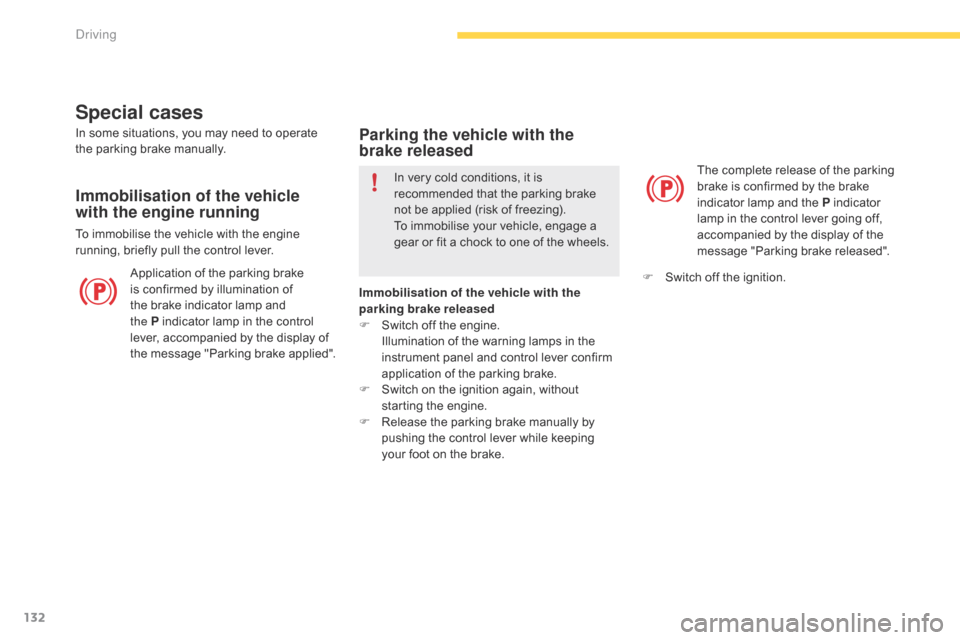
132
Special cases
Applicationô ofô theô parkingô brakeô is ô confirmed ô by ô illumination ô of ô
t
he ô brake ô indicator ô lamp ô and ô
t
he Pô indicator ô lamp ô in ô the ô control ô
l
ever, ô accompanied ô by ô the ô display ô of ô
t
he
ô m
essage
ô "
Parking
ô b
rake
ô a
pplied". The
ô complete ô release ô of ô the ô parking ô
b
rake ô is ô confirmed ô by ô the ô brake ô
i
ndicator ô lamp ô and ô the ô P ô indicator ô
l
amp ô in ô the ô control ô lever ô going ô off, ô
a
ccompanied ô by ô the ô display ô of ô the ô
m
essage ô "Parking ô brake ô released".
In
ô
some
ô
situations, ô you ô may ô need ô to ô operate ô
t
he
ô
parking ô brake ô manually.
Immobilisation of the vehicle
with the engine running
Toô immobiliseô theô vehicleô withô theô engineô r
unning, ô briefly ô pull ô the ô control ô lever.
Parking the vehicle with the
brake released
Inô veryô coldô conditions,ô itô isô recommended ô that ô the ô parking ô brake ô
n
ot ô be ô applied ô (risk ô of ô freezing).
To
ô immobilise ô your ô vehicle, ô engage ô a ô
g
ear ô or ô fit ô a ô chock ô to ô one ô of ô the ô wheels.
Immobilisation of the vehicle with the
parking brake released
F
ô
S
witch ô off ô the ô engine.
ô I
llumination ô of ô the ô warning ô lamps ô in ô the ô
i
nstrument ô panel ô and ô control ô lever ô confirm ô
a
pplication ô of ô the ô parking ô brake.
F
ô
S
witch ô on ô the ô ignition ô again, ô without ô
s
tarting ô the ô engine.
F
ô
R
elease ô the ô parking ô brake ô manually ô by ô
p
ushing ô the ô control ô lever ô while ô keeping ô
y
our ô foot ô on ô the ô brake. F
ô
S
witch ô off ô the ô ignition.
Driving
Page 135 of 523
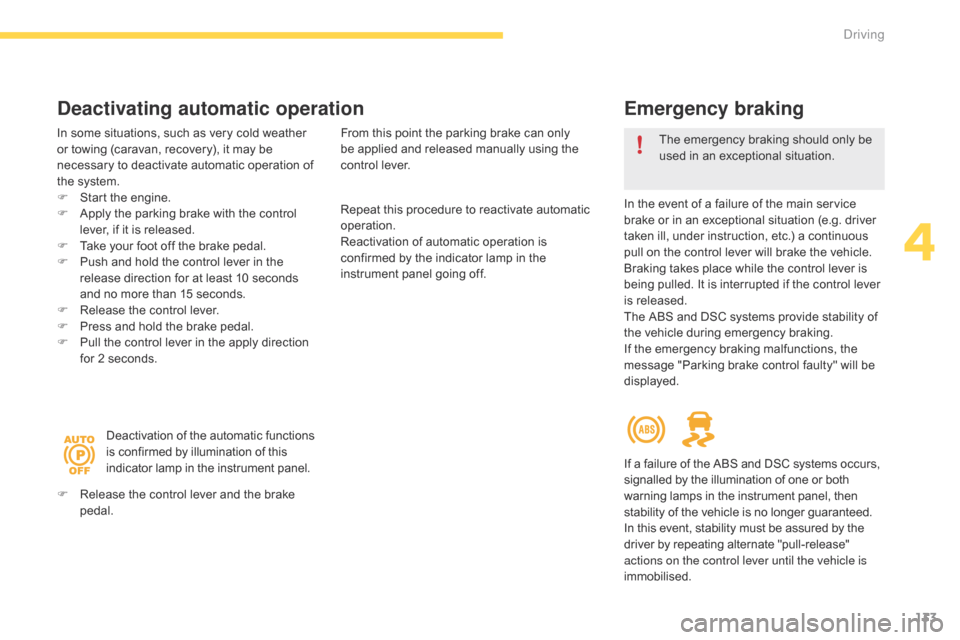
133
Emergency braking
Inô theô eventô ofô aô failureô ofô theô mainô serviceô brake ô or ô in ô an ô exceptional ô situation ô (e.g. ô driver ô
t
aken ô ill, ô under ô instruction, ô etc.) ô a ô continuous ô
p
ull ô on ô the ô control ô lever ô will ô brake ô the ô vehicle. ô
B
raking ô takes ô place ô while ô the ô control ô lever ô is ô
b
eing ô pulled. ô It ô is ô interrupted ô if ô the ô control ô lever ô
i
s
ô r
eleased.
The
ô ABS ô and ô DSC ô systems ô provide ô stability ô of ô
t
he ô vehicle ô during ô emergency ô braking.
If
ô the ô emergency ô braking ô malfunctions, ô the ô
m
essage ô "Parking ô brake ô control ô faulty" ô will ô be ô
d
isplayed.
If
ô a ô failure ô of ô the ô ABS ô and ô DSC ô systems ô occurs,
ô s
ignalled ô by ô the ô illumination ô of ô one ô or ô both
ô w
arning ô lamps ô in ô the ô instrument ô panel, ô then
ô s
tability ô of ô the ô vehicle ô is ô no ô longer ô guaranteed.
In
ô this ô event, ô stability ô must ô be ô assured ô by ô the
ô d
river ô by ô repeating ô alternate ô "pull-release"
ô a
ctions on the control lever until the vehicle is
immobilised. The
ô emergency ô braking ô should ô only ô be ô
u
sed ô in ô an ô exceptional ô situation.
Repeat
ô
this
ô
procedure
ô
to
ô
reactivate
ô
automatic
ô
ope
ration.
Reactivation
ô
of
ô
automatic
ô
operation
ô
is
ô
c
onfirmed
ô
by
ô
the
ô
indicator
ô
lamp
ô
in
ô
the
ô
i
nstrument
ô
panel
ô
going
ô
off.
Deactivating automatic operation
Inô someô situations,ô suchô asô veryô coldô weatherô o r ô towing ô (caravan, ô recovery), ô it ô may ô be ô
n
ecessary ô to ô deactivate ô automatic ô operation ô of ô
t
he ô system.
F
ô
S
tart ô the ô engine.
F
ô
A
pply ô the ô parking ô brake ô with ô the ô control ô
l
ever, ô if ô it ô is ô released.
F
ô
T
ake ô your ô foot ô off ô the ô brake ô pedal.
F
ô
P
ush ô and ô hold ô the ô control ô lever ô in ô the ô
r
elease ô direction ô for ô at ô least ô 10 ô seconds ô
a
nd ô no ô more ô than ô 15 ô seconds.
F
ô
R
elease ô the ô control ô lever.
F
ô
P
ress ô and ô hold ô the ô brake ô pedal.
F
ô
P
ull ô the ô control ô lever ô in ô the ô apply ô direction ô
f
or ô 2 ô seconds.
Deactivation
ô of ô the ô automatic ô functions
ô i
s ô confirmed ô by ô illumination ô of ô this
ô i
ndicator ô lamp ô in ô the ô instrument ô panel.
F
ô
R
elease ô the ô control ô lever ô and ô the ô brake ô
ped
al. From
ô this ô point ô the ô parking ô brake ô can ô only ô b
e ô applied ô and ô released ô manually ô using ô the ô
c
ontrol ô lever.
4
Driving
Page 136 of 523

134
Operating faults
Theô variousô alertô situationsô areô describedô inô theô tableô below.
I n ô the ô event ô of ô a ô fault ô with ô the ô electric ô parking ô brake ô it ô is ô recommended ô that ô you ô contact ô a ô CITROûN ô dealer ô or ô a ô qualified ô workshop ô without ô delay.
Situations Consequences
Display
ô of ô the ô message ô "Parking brake fault "
ô and ô this ô
w
arning
ô lam
p: -
ô
A
utomatic ô release ô is ô not ô available.
-
ô
I
f ô you ô attempt ô an ô automatic ô release, ô a ô help ô message ô is ô displayed ô on ô acceleration ô
w
hen ô the ô parking ô brake ô is ô applied, ô prompting ô you ô to ô use ô manual ô release.
Display
ô of ô the ô message ô "Parking brake fault "
ô and ô these ô
w
arning
ô lam
ps: -
ô
S
econdary ô braking ô does ô not ô have ô full ô power.
-
ô
I
f ô automatic ô release ô is ô not ô available, ô a ô help ô message ô is ô displayed ô on ô acceleration ô
w
hen ô the ô parking ô brake ô is ô applied, ô prompting ô you ô to ô use ô manual ô release.
Display
ô of ô the ô message ô "Parking brake fault "
ô and ô these ô
w
arning
ô lam
ps: -
ô
A
utomatic ô application ô is ô not ô available: ô use ô the ô control ô lever.
-
ô
T
he ô electric ô parking ô brake ô can ô only ô be ô used ô manually.
-
ô
I
f ô automatic ô release ô is ô also ô not ô available, ô a ô help ô message ô is ô displayed ô on ô
a
cceleration ô when ô the ô parking ô brake ô is ô applied, ô prompting ô you ô to ô use ô manual ô
r
elease.
Display
ô of ô the ô message ô "Parking brake fault "
ô and ô these ô
w
arning
ô lam
ps: -
ô
I
f ô manual ô application ô and ô release ô do ô not ô work, ô the ô control ô lever ô is ô faulty.
-
ô
T
he ô automatic ô functions ô must ô be ô used ô in ô all ô circumstances: ô they ô are ô
a
utomatically ô reactivated ô in ô the ô event ô of ô failure ô of ô the ô control ô lever.
-
ô
Y
ou ô can ô no ô longer ô immobilise ô the ô vehicle ô with ô the ô engine ô running.
Driving
Page 137 of 523
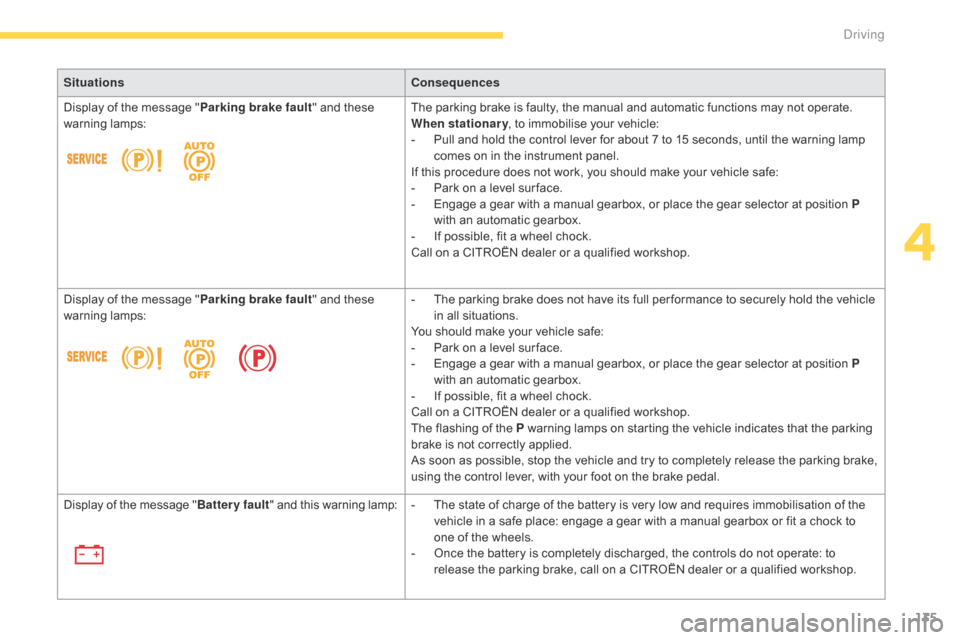
135
SituationsConsequences
Display ô of ô the ô message ô "Parking brake fault "
ô and ô these ô
w
arning
ô lam
ps: The
ô parking ô brake ô is ô faulty, ô the ô manual ô and ô automatic ô functions ô may ô not ô operate.
When stationary ,
ô to ô immobilise ô your ô vehicle:
-
ô
P
ull ô and ô hold ô the ô control ô lever ô for ô about ô 7 ô to ô 15 ô seconds, ô until ô the ô warning ô lamp ô
c
omes ô on ô in ô the ô instrument ô panel.
If
ô this ô procedure ô does ô not ô work, ô you ô should ô make ô your ô vehicle ô safe:
-
ô
P
ark ô on ô a ô level ô sur face.
-
ô
E
ngage ô a ô gear ô with ô a ô manual ô gearbox, ô or ô place ô the ô gear ô selector ô at ô position ô P
with
ô an ô automatic ô gearbox.
-
ô
I
f ô possible, ô fit ô a ô wheel ô chock.
Call
ô on ô a ô CITROûN ô dealer ô or ô a ô qualified ô workshop.
Display
ô of ô the ô message ô "Parking brake fault "
ô and ô these ô
w
arning
ô lam
ps: -
ô
T
he ô parking ô brake ô does ô not ô have ô its ô full ô per formance ô to ô securely ô hold ô the ô vehicle ô
i
n ô all ô situations.
You
ô should ô make ô your ô vehicle ô safe:
-
ô
P
ark ô on ô a ô level ô sur face.
-
ô
E
ngage ô a ô gear ô with ô a ô manual ô gearbox, ô or ô place ô the ô gear ô selector ô at ô position ô P
with
ô an ô automatic ô gearbox.
-
ô
I
f ô possible, ô fit ô a ô wheel ô chock.
Call
ô on ô a ô CITROûN ô dealer ô or ô a ô qualified ô workshop.
The
ô flashing ô of ô the ô P ô warning ô lamps ô on ô starting ô the ô vehicle ô indicates ô that ô the ô parking ô
b
rake ô is ô not ô correctly ô applied.
As
ô soon ô as ô possible, ô stop ô the ô vehicle ô and ô try ô to ô completely ô release ô the ô parking ô brake, ô
u
sing ô the ô control ô lever, ô with ô your ô foot ô on ô the ô brake ô pedal.
Display
ô of ô the ô message ô "Battery fault "
ô and ô this ô warning ô lamp:-
ô
T
he ô state ô of ô charge ô of ô the ô battery ô is ô very ô low ô and ô requires ô immobilisation ô of ô the ô
v
ehicle ô in ô a ô safe ô place: ô engage ô a ô gear ô with ô a ô manual ô gearbox ô or ô fit ô a ô chock ô to ô
o
ne ô of ô the ô wheels.
-
ô
O
nce ô the ô battery ô is ô completely ô discharged, ô the ô controls ô do ô not ô operate: ô to ô
r
elease ô the ô parking ô brake, ô call ô on ô a ô CITROûN ô dealer ô or ô a ô qualified ô workshop.
4
Driving
Page 138 of 523
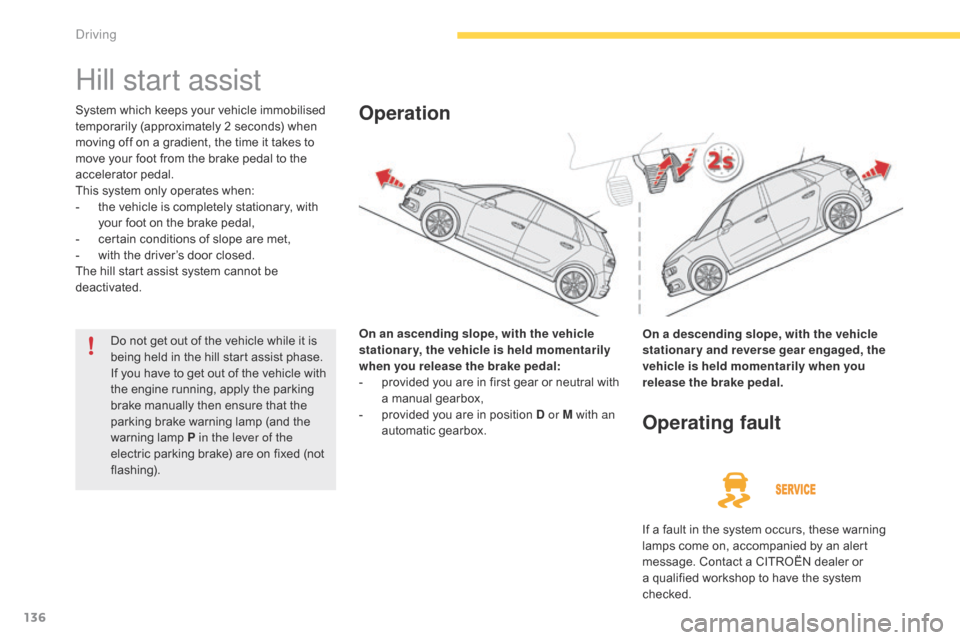
136
Hill start assist
Systemô whichô keepsô yourô vehicleô immobilisedô temporarily ô (approximately ô 2 ô seconds) ô when ô
m
oving ô off ô on ô a ô gradient, ô the ô time ô it ô takes ô to ô
m
ove ô your ô foot ô from ô the ô brake ô pedal ô to ô the ô
a
ccelerator
ô ped
al.
This
ô system ô only ô operates ô when:
-
ô
t
he ô vehicle ô is ô completely ô stationary, ô with ô
y
our ô foot ô on ô the ô brake ô pedal,
-
ô
c
ertain ô conditions ô of ô slope ô are ô met,
-
ô
w
ith ô the ô driverãs ô door ô closed.
The
ô hill ô start ô assist ô system ô cannot ô be ô
d
eactivated. On an ascending slope, with the vehicle
stationary, the vehicle is held momentarily
when you release the brake pedal:
-
ô
p
rovided ô you ô are ô in ô first ô gear ô or ô neutral ô with ô
a
ô manual ô gearbox,
-
ô
p
rovided ô you ô are ô in ô position ô D or M with an
automatic
ô gearbox.Operation
On a descending slope, with the vehicle
stationary and reverse gear engaged, the
vehicle is held momentarily when you
release the brake pedal.
Operating fault
Ifô aô faultô inô theô systemô occurs,ô theseô warningô lamps ô come ô on, ô accompanied ô by ô an ô alert ô
m
essage. ô Contact ô a ô CITROûN ô dealer ô or ô
a
ô qualified ô workshop ô to ô have ô the ô system ô
c
hecked.
Do
ô
not
ô
get
ô
out
ô
of
ô
the
ô
vehicle
ô
while
ô
it
ô
is
ô
b
eing
ô
held
ô
in
ô
the
ô
hill
ô
start
ô
assist
ô
phase.
If
ô
you
ô
have
ô
to
ô
get
ô
out
ô
of
ô
the
ô
vehicle
ô
with
ô
t
he
ô
engine
ô
running,
ô
apply
ô
the
ô
parking
ô
b
rake
ô
manually
ô
then
ô
ensure
ô
that
ô
the
ô
p
arking
ô
brake
ô
warning
ô
lamp
ô
(and
ô
the
ô
w
arning
ô lam
p
ô P
in the lever of the
electric
ô
parking
ô
brake)
ô
are
ô
on
ô
fixed
ô
(not
ô
f
lashing).
Driving
Page 139 of 523
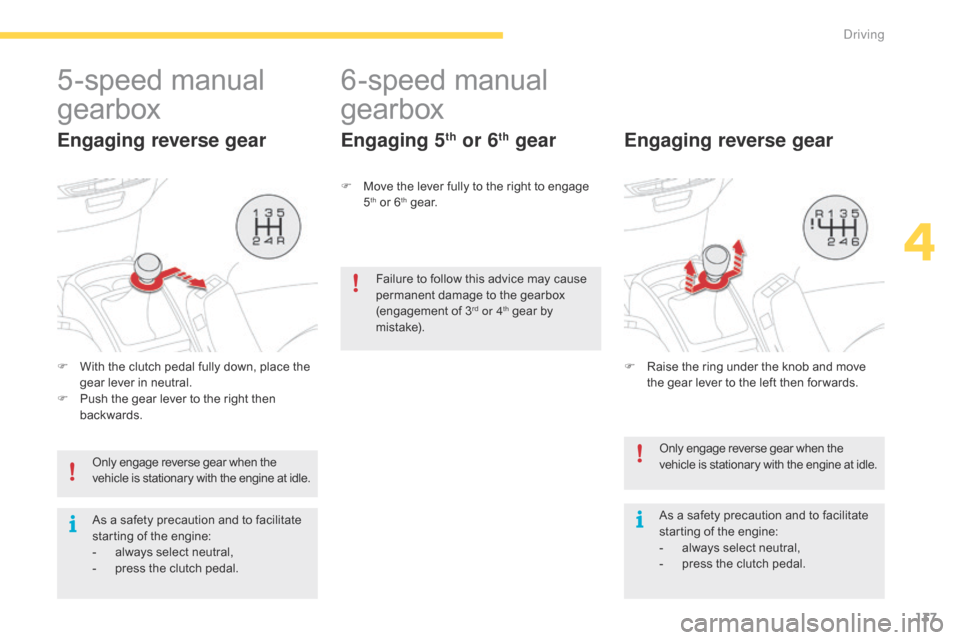
137
5-speedô manualô
g
earbox
Engaging reverse gear
Fô With ô the ô clutch ô pedal ô fully ô down, ô place ô the ô g
ear ô lever ô in ô neutral.
F
ô
P
ush ô the ô gear ô lever ô to ô the ô right ô then ô
ba
ckwards.
Only
ô engage ô reverse ô gear ô when ô the
ô v
ehicle ô is ô stationary ô with ô the ô engine ô at ô idle.
As
ô a ô safety ô precaution ô and ô to ô facilitate ô
s
tarting ô of ô the ô engine:
-
ô
a
lways ô select ô neutral,
-
ô
p
ress ô the ô clutch ô pedal.
6-speedô manualô
g
earbox
Engaging 5th or 6th gear
Fô Move ô the ô lever ô fully ô to ô the ô right ô to ô engage ô 5thô orô 6thô ge a r.
Only ô engage ô reverse ô gear ô when ô the
ô v
ehicle ô is ô stationary ô with ô the ô engine ô at ô idle.
As
ô a ô safety ô precaution ô and ô to ô facilitate ô
s
tarting ô of ô the ô engine:
-
ô
a
lways ô select ô neutral,
-
ô
p
ress ô the ô clutch ô pedal.
Engaging reverse gear
Failureô toô followô thisô adviceô mayô causeô permanent ô damage ô to ô the ô gearbox ô
(
engagement
ô o
f
ô 3rd or 4thô gearô byô m
i st a ke).
F
ô
R
aise ô the ô ring ô under ô the ô knob ô and ô move ô
t
he ô gear ô lever ô to ô the ô left ô then ô for wards.
4
Driving
Page 140 of 523
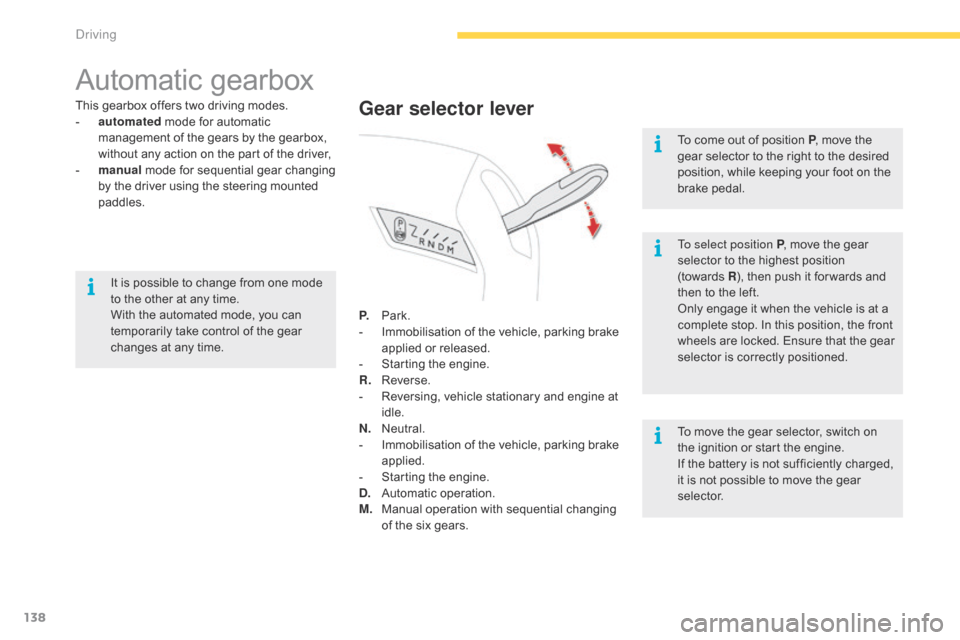
138
Automaticô gearbox
Thisô gearboxô offersô twoô drivingô modes.
- ô a utomatedô mode ô for ô automatic ô
m
anagement ô of ô the ô gears ô by ô the ô gearbox, ô
w
ithout ô any ô action ô on ô the ô part ô of ô the ô driver,
-
ô
m
anual
ô
mode ô for ô sequential ô gear ô changing ô
b
y ô the ô driver ô using ô the ô steering ô mounted ô
p
addles.
P.
ô Pa
rk.
-
ô
I
mmobilisation ô of ô the ô vehicle, ô parking ô brake ô
a
pplied ô or ô released.
-
ô
S
tarting ô the ô engine.
R.
ô R
everse.
-
ô
R
eversing, ô vehicle ô stationary ô and ô engine ô at ô
i
dle.
N.
ô N
eutral.
-
ô
I
mmobilisation ô of ô the ô vehicle, ô parking ô brake ô
a
pplied.
-
ô
S
tarting ô the ô engine.
D.
ô A
utomatic
ô ope
ration.
M.
ô M
anual ô operation ô with ô sequential ô changing ô
o
f ô the ô six ô gears.Gear selector lever
To select position P, ô move ô the ô gear ô s
elector ô to ô the ô highest ô position ô
(
towardsô R),
ô then ô push ô it ô for wards ô and ô
t
hen ô to ô the ô left.
Only
ô engage ô it ô when ô the ô vehicle ô is ô at ô a ô
c
omplete ô stop. ô In ô this ô position, ô the ô front ô
w
heels ô are ô locked. ô Ensure ô that ô the ô gear ô
s
elector ô is ô correctly ô positioned.
To
ô move ô the ô gear ô selector, ô switch ô on ô
t
he ô ignition ô or ô start ô the ô engine.
If
ô the ô battery ô is ô not ô sufficiently ô charged, ô
i
t ô is ô not ô possible ô to ô move ô the ô gear ô
s
elector.
To
ô come ô out ô of ô position ô P
, ô move ô the ô
g
ear ô selector ô to ô the ô right ô to ô the ô desired ô
p
osition, ô while ô keeping ô your ô foot ô on ô the ô
b
rake
ô ped
al.
It
ô
is
ô
possible
ô
to
ô
change
ô
from
ô
one
ô
mode
ô
t
o
ô
the
ô
other
ô
at
ô
any
ô
time.
With
ô
the
ô
automated
ô
mode,
ô
you
ô
can
ô
t
emporarily
ô
take
ô
control
ô
of
ô
the
ô
gear
ô
c
hanges
ô
at
ô
any
ô
time.
Driving